
The loss of primary sources of rubber – plantations in the Far East - during World War II prompted crash programmes of research and production of synthetic rubber in order to meet the needs of industry and the war effort.
Nylon turned out to be another strategic material, serving as “artificial silk” for parachutes. In Germany a large factory was built by I.G. Farben at Buna exploiting the slave work of the Auschwitz prisoners.
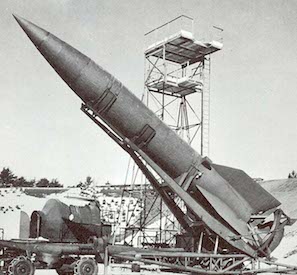
Germany put a great emphasis on research and production of new bombers and fighters. They were the first to deploy airplanes with jet engines, followed later by the British RAF. The German V-2 (Vergeltungswaffen Zwei) was a landmark in the advance of rocketry. Propelled by alcohol and liquid oxygen, the V-2 was the first ballistic missile, i.e. a self-propelled rocket which after launch only follows a trajectory determined by gravity. V-2 went faster than the speed of sound, but they were not very accurate. For example, across a range of 320km, only one third of V-2s would hit within 5km of their target.
Image left: A V-2 misile on its mobile launcher at Meillerwagen in 1943. After the war, captured V-2s were extensively studied by Soviet and American researchers and their technology was the starting point for the two powers' space programmes.In 1940, the British Army‘s anti-aircraft command organized a group of scientists under physicist P.A.M. Blackett to study the operational use of radar, guns, and mechanical calculators for anti-aircraft fire. At the Admiralty from 1942 to 1945, this group brought about significant improvement in the use of airborne radar for finding German submarines that were sinking merchant ships in the Atlantic.
From their work a new field of mathematics – called operational research – evolved for treating complex optimization problems. Operational research moved in 1942 to USA, where it was developed for military purposes at the Princeton University and at the Massachusetts Institute of Technology.
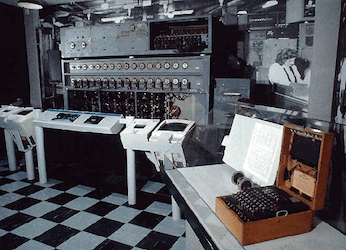
World War II also sees the development and the first systematic use of digital computers to solve military problems. In Germany, Konrad Zuse’s computer was used for the aircraft industry. In the UK, the Colossus, the first electronic digital computer, was developed for cracking German codes. In the USA, Harvard’s electromechanical Mark I and US Army’s electronic ENIAC produced shooting tables for artillery and other military computations. ENIAC was also used for the development of the atomic bomb.
Image above right: The wooden device in the foreground is a four rotor German Enigma machine, used for encoding. The large machine in the background is a “Bombe” used for breaking the code.The use of radio waves to detect and locate objects was suggested as early as 1900 by Nikola Testa. The military advantages became of critical importance in World War II in the air Battle of England and in the Pacific Ocean operations.
A tube for generating microwave power, fundamental for the success of radar, the cavity magnetron, was developed in UK around 1940. A dedicated Radiation Laboratory was created at the Massachusetts Institute of Technology, where several American physicists were employed.
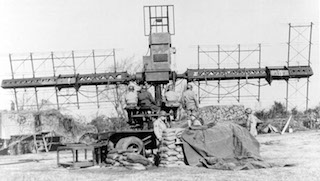
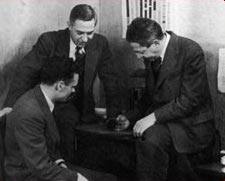

The 1941 German attack found Soviet Union’s military structures largely unprepared, allowing a rapid invasion of Russian territories. Soviet industry had to produce new weapon systems, and scientists and scientific institutions were called to develop materials for tanks, aircrafts and armaments suited to operations in the extreme conditions of Russian winter.
The T-34 tank had a profound and lasting influence on later tank tactics and design. First deployed in 1940, it is considered the most effective, efficient and influential design of World War II.Immediately after the observation by Otto Frisch and Lise Meitner of the large energy released in the fission of uranium (December 1938) and Enrico Fermi’s suggestion of the possibility of a chain reaction (January 1939), the possible military uses of fission processes became apparent to the community of nuclear physicists. Leo Szilard’s proposal to restrain from publishing new results was seriously considered, but not actually accepted. In the spring of 1939 governments, or military authorities, of the USA, Germany, Soviet Union, France and UK were made aware of the possible military applications of nuclear fission.
Problems: Timing – fast neutrons
However, the construction of a nuclear bomb presents extremely different problems from those involved in the construction of a nuclear reactor. The fundamental problem is the necessity of simultaneous fissions of a huge number of nuclei in a time short enough to prevent the dispersion of the fissile material due to heating. An explosion equivalent to 20kt of chemical explosive (TNT) requires fission of 1kg of 235U, which implies a 80-fold long chain reaction. Since fission occurs in about 10-8s, 80 neutron generations pass in 0.8 microseconds. Neutrons need about 1 microsecond to be slowed down and therefore a bomb must operate with the fast neutrons as they are produced, without a moderator.
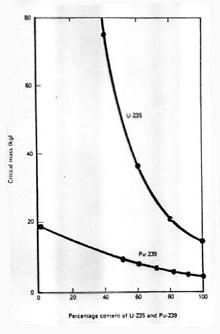
Fissile Material Critical Mass
A large fraction of the neutrons released in the fission process have less than 1Mev of energy and thus are unable to induce the fission of a 238U nucleus. Therefore, nuclear weapons only use 235U or 239Pu. The minimum mass depends on the purity of the fissile material but can be greatly reduced by surrounding the core by a layer of heavy material – the tamper – which reflects neutrons back and retards the expansion of the active material. For example, a thick U tamper reduces the critical mass of a sphere of pure 235U from 56kg to 15kg and of 239Pu from 11kg to 5kg.
Image right: Curves of critical masses of 235U and 239Pu as a function of their purity.Bomb design
To be useful, a nuclear weapon must be easy to handle safely and must operate without fail. It must also be small enough to be delivered to its target. All these conflicting conditions have to be achieved, requiring the cooperative collaboration of experts in many fields. In particular, the necessary scientific knowledge includes precise determination of fission probabilities and of the behavior of fissile materials in function of pressure and temperature.
Detonation Mechanisms
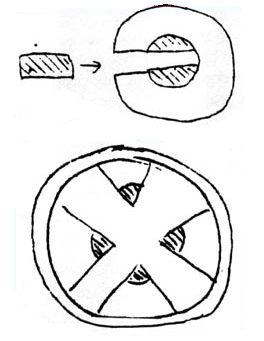
Before firing, the active material must be prepared in such a way that a chain reaction cannot develop, taking into account all possible sources of neutrons. The act of firing consists in a volume rearrangement which ensures the configuration necessary for a chain reaction. There are two basic approaches.
In the gun technique, one sub-critical mass is propelled by a high velocity conventional gun into another sub-critical mass.
The implosion technique uniformly detonates a peripheral charge of chemical explosive in a manner designed to compress a sub-critical mass into a supercritical configuration. For 235U weapons both techniques are possible, but for plutonium weapons, owing to the presence of spontaneously fissionable 240Pu, only the implosion technique is feasible.
Image left: Schematic drawings of the two detonation mechanisms - from Los Alamos, early 1943.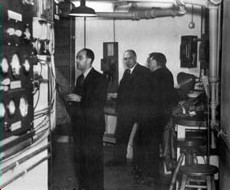
During 1939, at the Columbia University in New York, research on basic properties of fission is carried out by Fermi’s and John Dunning’s groups with limited financial support from the US Navy. While Fermi was aiming to obtain a chain reaction with natural uranium and graphite moderators, Dunning began research on uranium enrichment of the 235U isotope. At Princeton, Niels Bohr and John Wheeler develop the basic theory of fission, stressing the importance of 235U.
Image left: Fermi, Bohr and Léon Rosenfeld at the Carnegie Institution in 1939. Fission was demonstrated at the Department of Terrestrial Magnetism (DTM) on 28 January 1939.France
In Paris Hans von Halban, Lew Kowarski, Francis Perrin and Frédéric Joliot-Curie realize that slow neutrons are more effective for producing fissions and started using first hydrogen and then heavy water to slow down the fission neutrons. In October 1939 they obtain an approximate formula for the law of the chain reaction, which they will keep secret until the end of World War II. After the German invasion of France von Halban and Kowarski take their heavy water to England and join the British research team. Joliot continues his researches in France, where he takes part to the resistance against the Nazis.
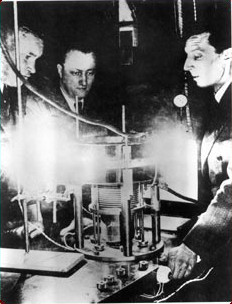
Germany
As soon as March 1939, the German government starts being interested in nuclear fission. In September a Uranium Project is formally constituted under the responsibility of Kurt Diebner. The Kaiser Wilhelm Institut für Physik in Berlin-Dahlem becomes the scientific center and work is done in several institutes around Germany. The use of heavy water and the isotope separation are the main research themes. Heisenberg develops the theory of fission. In Summer 1941 at Leipzig a sub critical heavy-water moderated pile is already operating. Fritz Houtermans defines various aspects of the fission and suggests the use of element 94 (plutonium) produced by 238U. At Berlin a large sub critical pile is built using 500l of heavy water.
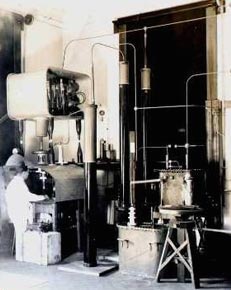
In 1942 Heisenberg was convinced of the impossibility of building a nuclear weapon, due to the difficulties of separating 235U. On 4-6 June 1942 the Uranium Committee presented its results to Minister Albert Speer and Marshal Erhald Milch: it was decided to give priority to the production of nuclear power. The possibility of a nuclear engine for the Navy was considered and a large stockpile is built during winter 1944 at Dahlem with 1.5t of Uranium and 1.5t of heavy water. After the bombing of the institute the research is transferred to a cave at Hechingen in Bavaria. The instruments and the scientists will be captured by US forces on April 22, 1945.
Image left: The Uranium laboratory at Dahlem.The Soviet Union
Experimental and theoretical research on fission started immediately in the Russian city of Leningrad (now known as St. Petersburg) and in a series of seminal papers by Yakov Borisovich Zel’dovich and Yuli Khariton in 1939-40 the basic principles of fission chain reaction were outlined.
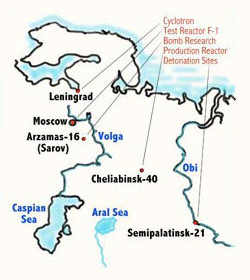
In 1940, a program for the exploitation of fission was presented to Presidium of the Academy of Sciences. At Leningrad in June 1941 Kurchatov’s group starts operation with a newly-built cyclotron. However, during the German invasion of Russia (June 1941) Stalin stops research on fission.
In July 1945 Stalin decided to begin a crash programme to develop nuclear power under the leadership of Igor Kurchatov. A secret laboratory (Arzamas-16) was built by war prisoners near Arzamas, some 400km East of Moscow. Several German scientists and materials from German laboratories helped speeding up the Russian project.
Image right: Map of the first Soviet nuclear laboratories.
Britain: The Frisch-Peierls memorandum
The start of the British program on nuclear weapons was a result of the research performed in Birmingham by two refugees: the German Rudolph Ernst Peierls and the Austrian Otto Frisch. On March 19, 1940 they present to Henry Tizard, President of the Imperial College, two confidential memoranda: “on the Properties of a Radioactive ‘Superbomb’” and “On the Construction of a ‘Superbomb’ Based on a Nuclear Chain Reaction in Uranium”.
In their memorandum, they argue the feasibility of a 235U fast neutron explosive chain reaction with a critical mass of only 1kg. They describe the gun detonation mechanism and explore the weapon’s effects and insist on starting a research program to counterbalance the German nuclear developments.

The Frisch-Peierls memorandum, making the prospect of a uranium weapon affordable, convinced the RAF to start a strong research program (the MAUD Committee) under George Thompson with groups at Liverpool (James Chadwick), Birmingham (Oliphant and Peierls), Oxford (for isotope separation) and at the Imperial Chemical Industries.
Image left: Mark Oliphant at the Birmingham Physics Department in 1941.After the fall of France, the Parisian scientists brought their expertise to the UK along with their heavy water. On July 7 1941 the MAUD Committee presents to the Government detailed documents outlining the military and civilian uses of fission. Churchill gives high priority to both areas of research; the “Directorate Tube Alloys” is created under the control of John Anderson, Lord President of the Council. By the end of 1941 the British program was the most advanced in the world.
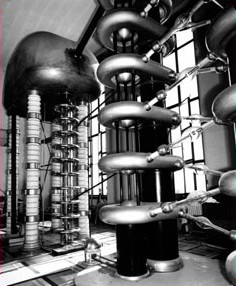
Italy
The nuclear physics group in Rome, founded by Fermi and lead by Edoardo Amaldin after Fermi’s departure to the USA in 1939, specialised in neutron-induced reactions. It was important to conduct research on fission in order to understand why the group had earlier on confused this reaction with the production of transuranic elements in 1936.
However, in 1941 the Rome group decided to cease all research on fission because of its military implications.
Image right: The 200kV Cockroft-Walton proton accelerator in use from 1939 by nuclear physics group in Rome.Yoshio Nishina began research on nuclear weapons in summer 1940 at the Riken laboratory in Tokyo, with limited support from the Japanese army. At Kyoto, the Imperial Navy supported the research by Bunsaku Arakatsu. Competition between the Navy and the Air force resulted in limited progress until spring 1943, when first separation plants were produced. However, the project never reached an effective size. After the bombing of Hiroshima, Nishina flew over the town and recognized the terrifying nature of a nuclear attack.